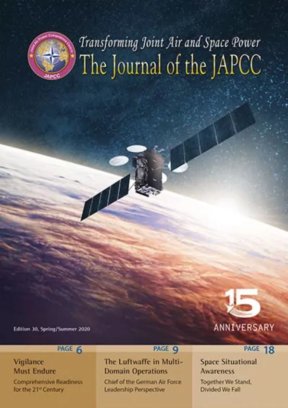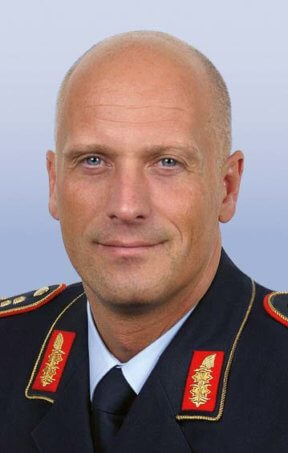Introduction
NATO is living through one of the most challenging periods of its existence. Our security environment has become even more complex and increasingly dynamic. Our security situation is characterized by crises, conflicts and the revival of traditional power policies. The upcoming decades require extraordinary capabilities of civil and military interagency cooperation and capacities to fight and win in an increasingly multi-domain information battlespace.
Today’s challenges require a shared vision of how we will shape our national forces and NATO beyond branch barriers for joint all-domain operations. For NATO to maintain its status of being able to respond to all security challenges it must continue to understand the multi-domain battlespace.
The Joint Air & Space Power Conference hosted annually by the Joint Air Power Competence Centre (JAPCC) has established itself as an internationally recognized open-discussion forum on relevant issues for the Alliance. The subject ‘Multi-Domain Operations’ was the perfect focus of the JAPCC Conference 2019: Which challenges does the transatlantic Alliance face in order to meet the requirements? What are the future enablers to cope with these challenges?
Keynotes, panel discussions and side-talks emphasized our common interest in further pushing ahead with our common understanding. What we need is a shared vision on the definition and the requirements of a multi-domain operation.
The side-talks with speakers, panellists and participants were informative and enlightening. The face-to-face meetings with General Jeffrey L. Harrigian, Lieutenant General David D. Thompson together with Lieutenant General Klaus Habersetzer were of utmost importance.
The JAPCC Conference was an outstanding opportunity not only to meet old friends and make new ones but also to discuss important issues. My keynote was the starting point of the second conference day taking up the results already achieved.
Key Factors Addressing the Transition Towards Multi-Domain Operations
Cooperation and interoperability are in our DNA within our service. For airmen, thinking in multi-domain operations is nothing unusual. Our service was born from airpower’s promise of combat effects that could enable success on the whole battlefield. It is part of our culture. However, thinking in a multi-domain culture is not the same as creating kinetic and non-kinetic effects from different partner nations in different domains, time-spaced by seconds and having immediate contingency effects ready for individual missed or denied targets.
Therefore, ‘joint’ and ‘combined’ is not the same as an ‘effects-based synchronized’ tactical integrated all-domain mission. The new Luftwaffe rule of thumb is ‘single-domain planning will definitely prevent proper performance’.
Even though operations within a multi-domain environment are nothing new, ‘real-time integrated’ manoeuvres on a tactical level between air, land, sea forces or cyber and space elements are still a challenge, especially for a coalition of nations like NATO. The German Air Force is well aware of its responsibility – not just for the domain air!
The following four theses cover a wide spectrum and highlight the key factors that determine how we will master the transition towards multi-domain operations and Command and Control (C2).
JAPCC Journal readers and all-domain experts can take these theses as my offer for an open dialogue. Dig into them, add your comments, and either agree or prove them wrong in your papers on joint all-domain operations/C2.
We must understand the significance of the lingering merger of our dimensions into that all-domain principle.
Command and control, structure, organization, communication and weapon systems – all areas are equally affected.
In particular: Cyber and space are crucial to all other domains. It is time for us, regardless of our specialty badges, to embrace space and cyber superiority with the same passion and sense of ownership as we apply to air superiority today.
Cyber has unique warfighting capabilities and is of interest because the barriers and entry costs tend to be lower. Cyber actors can change their environment to both their advantage and their enemies’ disadvantage.
Space actors have direct contact and access to all traditional domains.
The cyber and space domains have a very dynamic and extensive nature, and the future of our security depends on the space and cyber domains and their integration into the existing construct. Their usage will further merge the traditional domains land, air and sea and will further raise the operational tempo.
The time to integrate the space and cyber domains into our operational mindset is NOW. Last year NATO adapted the ‘Overarching Space Policy’ and acknowledged space as an operational domain. Right now, we deliberate on the resulting consequences in all areas. As we need excellent expertise to fuel our current decision-making I think it is time to officially recognize the work of the JAPCC on Space matters for NATO since the Centre’s establishment 15 years ago and formalize a role the JAPCC has occupied since the beginning as ‘NATO’s Centre of Excellence (CoE) for Space’.
We must be prepared to give up our traditional way of thinking.
Traditionally, armed forces – and air forces, too – have focused on the physical and direct effect. Furthermore, we just recognized the importance of space and cyber usage. However, the underlying element, which holds it all together or separates domains by denying access, is the electromagnetic spectrum.
What will be more important in the future than the performance data and the speed of our fighter aircraft is the question whether the data transmission rate is high enough to respond to a new ‘character’ of warfare, and whether we can protect the data transmission and sensors’ field of view within and across domains? In this context we have identified electronic warfare as enabler, dependency and one of the top priorities.
We must continue to modify the way we think to further include the capabilities and contributions of forces from all domains – air, space, cyberspace, maritime, land – and therefore protect and dominate the electromagnetic spectrum.
As an example, we can think about the increased importance of escort and stand-in jamming, up to a sophisticated art and tactics with dedicated assets within air operation and as top cover for land units and sea platforms.
These assets are the indispensable enablers even for 5th generation jets to gain and sustain multi-domain control from the air for a certain time and 3D range.
Airborne electronic attack assets have to fight an intensive digital war to provide that tactical multi-domain bubble for others to use freedom of movement.
Furthermore – if we want to burst the all-domain Anti Access/Aerial Denial (A2AD) bubble, we need tactical integrated multi-domain Intelligence, Surveillance and Reconnaissance (ISR) at the front line. Modern ISR and battlefield connectivity are the heat that melts the kill chain to its shortest possible length. But both are only effective if we can protect their electromagnetic environment.
Our C2 needs a new ‘driver’s seat’. C2 must be ready to give up the traditional way of thinking and leave behind the well-trodden and rigidly hierarchical command structure at all levels, and we have to enable and allow the weapons system level to fight across domains in real-time.
In the future air battle, a 72 hours Ops cycle will likely be too long and an ‘Air’ Task Order might rather become a ‘Synchronized’ Task Order.
We need C2 command and control that permits smooth transitions between support and supporting roles and allows scalable distributed control and execution. The air dimension might be the perfect one to provide the tactical part of ‘distributed control’ if we manage to own the electromagnetic environment. We need a new level of operational agility, in both planning and execution.
Multi-domain C2 requires dynamic action at the tactical level. Agile decision-making is critical to the success of joint all-domain integration and can be achieved only in a culture of bottom-up innovation and bold leadership.
In the area of information processing, C2 needs to take a new approach.
The air force can generate an immense amount of data. But much of this data is often of little sense or utility to a fused picture in the conduct of operations.
The big question is what information should be shared, and with whom, to best enable the delivery of the right effect at the right place at the right time. Is it sensor-, data- or info-, meaning low-, mid- or high-level fusion, which is needed between which assets and with which level of integration? That will be the crucial question for the Future Combat Air System (FCAS).
The aspect of multi-domain operations must be considered in the development of all new systems, while we must not forget or neglect those systems that do not fully meet the modern technological requirements.
With our Next Generation Fighter we will open up options for specific applications featuring unmanned platforms, teaming and swarming.
It is obvious that we need a level of connectivity that is consistently designed to make multi-domain operations possible. Our level of ambition is to push forward our capabilities, not building up complexity of planning and fighting.
The demands are high and the Luftwaffe focuses on sophisticated and innovative cutting-edge technology.
Within the scope of the overall system, a new command fighter will be complemented by 4th generation legacy fighters like the ‘Eurofighter’, ‘Rafale’, ‘Hornet’ or the ‘Gripen’.
As a coalition, as NATO, we will only be able to unfold our full potential if we manage to integrate older weapon systems effectively and seamlessly into the multi-domain concept.
In this spirit, multi-domain operations will tie us even closer together. Only together will we be able to tackle the enormous and dynamic security challenges.
The participation in international exercises is a suitable way to achieve this goal. Multinational cooperation is the basis of interoperability – and interoperability is decisive for acting in joint all-domain operations.
We need both – a vision, but also the persistence to take many small steps.
The Luftwaffe, as well as NATO, already established a guiding idea, a vision that defines the long-term goals.
We need an integrated all-domain strategy that makes it unmistakably clear that ‘Multi-Domain Operations’ is more than a ‘slogan’ based on an unrealistic ambition; it is the predicted, and indeed the unavoidable, solution.
The success of multi-domain integration will depend on whether we share information, but also whether we cooperate in early testing and technology development.
What we need as much as a vision is a pragmatic short and medium-term approach. With many small steps we can turn visionary dreams into a real solution. That way we can produce visible progress and solutions for the most important resource of our forces: our personnel.
Education, training and leadership will have to evolve to guarantee that our personnel have the necessary knowledge and skills to understand the implications of an all-domain battlespace.
Multi-domain operation requires dynamic action at all levels. Operators must have not only the skill to perform their own mission in one domain. They must also understand how operators of other domains assure their mission accomplishment.
Moving forward, training and education will be key. It is important to train our airmen in a multi-domain manner from the beginning of their careers.
The Luftwaffe is opening its planning room doors to army, navy, cyber forces, allies and partners. We are prepared and willing to proceed to the future.
15th Anniversary of JAPCC
The ‘Joint Air & Space Power Conference 2019’ focusing on ‘Multi-Domain Operations’ perfectly hit the nerve of the time, once again confirming that the JAPCC is delivering valuable contributions to the future of NATO.
The JAPCC is NATO’s first accredited Centre of Excellence. For 15 years, JAPCC has been recognized as a driving force of NATO Air and Space Power. I congratulate the JAPCC Team for this outstanding success. Maintain your spirit with pride and continue this positive work.












